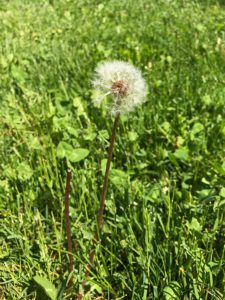June 25 Column: Dealing with Weeds

Don’t we all hate weeds? After all, they get in the way of the lovely plants we’ve placed in our gardens on purpose. I recently had a request to share some of my weed strategies, so have written a column on that very subject. Here’s a link to it in today’s edition of The Spokesman-Review: Best weeding tools are your fingers, but mulching and other things can help. (or you can read my column lower in this post)
You will find that everything I suggest is an organic solution. I know that a lot of folks like the “quick fix” herbicides but those chemicals cause more problems than what they are trying to address in their gardens.
But each of the weed strategies I employ works well and is quite simple. I’m hoping you’ll all take the pledge to leave the chemicals behind and go organic!! (and “going organic” does not mean going weedy, by the way)
For additional information on dealing with weeds — plus clarification of the methods I wrote about — here is this week’s “Everyone Can Grow A Garden!” video:
Garden column on Weeds:
by Susan Mulvihill
Let’s have a quick show of hands: who enjoys weeding? It looks like nobody does. The only redeeming quality I find in the job is that it slows me down long enough to check on the plants that I’m growing on purpose.
But the other huge reason for weeding is to keep them in check. I frequently receive reader emails asking for strategies to deal with or prevent weeds so here are some ideas:
Our strategies for dealing with weeds:
We have a raised bed vegetable garden. Prior to adding bark mulch to the pathways, we put down weed-block fabric, also known as landscape fabric. I rarely have to weed anywhere but on the top of each bed. We’ve done the same for the paths in our back garden, which is quite a time-saver.
And speaking of raised beds, if you want to set some onto an existing lawn or an area where weeds have been a problem, I have a strategy for that. Mow the lawn or weeds as short as possible and cover the area with cardboard, several layers of newspaper or weed-block fabric. Put the raised beds in place and fill them with soil. As long as a bed is over 6 inches deep, it will be very difficult for any weeds to come up through a barrier and that much soil inside the beds.
Mulch makes a big difference!
Mulching planters is also helpful. Placing a few inches of grass clippings from a non-herbicide-treated lawn or shredded leaves over the soil around plants will keep the majority of weed seeds from germinating. An added bonus is that mulch helps the soil retain moisture.
If you don’t use mulch and like having a freshly-cultivated look to the soil, you should know that frequent cultivation brings up new weed seeds to the surface. And of course, they’re only too happy to sprout and add to your workload. Minimal soil disturbance makes a difference.
When weeding, do your best to get the root rather than just the leaves and stems. There are many nasty types of weeds that spread underground by rhizomes (fleshy stems), so the goal is to get as much of the plant as you possibly can. Quack grass is a perfect example of this.
Don’t let weeds develop flowers because seeds will quickly follow and then you’ve really got trouble. I wouldn’t recommend putting weeds that have flowered into compost piles since most piles don’t get hot enough to kill off the weed seeds.
Another strategy is to crowd the plants in your beds. The more light and space your plants take up, the fewer weeds you’ll have. I’ve noticed that in my ornamental beds.
Solarizing the soil is another option for large problem areas. Place a clear sheet of plastic over the weedy area for 4 to 6 weeks during hot weather to fry those weeds. Not all weeds will be killed but it’s a good start. According to the University of California’s Integrated Pest Management Program, this method won’t leave chemical residues within the soil. This method is used for pest and disease problems as well.
Learn more at ipm.ucanr.edu/PMG/PESTNOTES/pn74145.html. You’ve probably noticed I haven’t mentioned any weed-killing or pre-emergent chemicals. That’s because I don’t want anything to do with them so I opt for an organic approach instead. My best weeding tools are my fingers and, even though I’m not crazy about weeding, it’s an eco-friendly alternative.

